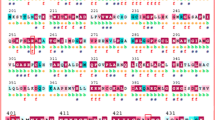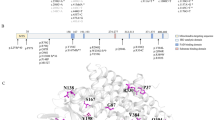Abstract
Background
This study aimed to investigate the mutation spectrum of the QDPR gene, to determine the effect of mutations on dihydropteridine reductase (DHPR) structure/function, to discuss the potential genotypephenotype correlation, and to evaluate the clinical outcome of Chinese patients after treatment.
Methods
Nine DHPR-deficient patients were enrolled in this study and seven of them underwent neonatal screening. QDPR gene mutations were analyzed and confirmed by routine methods. The potential pathogenicity of missense variants was analyzed using Clustal X, PolyPhen program and Swiss-PDB Viewer 4.04_OSX software, respectively. The clinical outcomes of the patients were evaluated after long-term treatment.
Results
In 10 mutations of the 9 patients, 4 were novel mutations (G20V, V86D, G130S and A175R), 4 were reported by us previously, and 2 known mutations were identified. R221X was a hotspot mutation (27.7%) in our patients. Eight missense mutations probably had damage to protein. Six patients in this series were treated with a good control of phenylalanine level. The height and weight of the patients were normal at the age of 4 months to 7.5 years. Four patients, who underwent a neonatal screening and were treated early, showed a normal mental development. In 2 patients diagnosed late, neurological symptoms were significantly improved.
Conclusions
The mutation spectrum of the QDPR gene is different in the Chinese population. Most mutations are related to severe phenotype. The determination of DHPR activity should be performed in patients with hyperphenylalaninemia. DHPR-deficient patients who were treated below the age of 2 months may have a near normal mental development.
Similar content being viewed by others
References
Werner ER, Blau N, Thöny B. Tetrahydrobiopterin: biochemistry and pathophysiology. Biochem J 2011;438:397–414.
Burke JR, Frey PA. The importance of binding energy in catalysis of hydride transfer by UDP-galactose 4-epimerase: A carbon-13 and nitrogen-15 NMR and kinetic study. Biochemistry 1993;32:13220–13230.
Swanson BA, Frey PA. Identification of lysine 153 as a functionally important residue in UDP-galactose 4-epimerase from Escherichia coli. Biochemistry 1993;32:13231–13236.
Kiefer PM, Varughese KI, Su Y, Xuong NH, Chang CF, Gupta P, et al. Altered Structural and Mechanistic Properties of Mutant Dihydropteridine Reductases. J Biol Chem 1996;271:3437–3444.
Lockyer J, Cook RG, Milstien S, Kaufman S, Woo SL, Ledley FD. Structure and expression of human dihydropteridine reductase. Proc Natl Acad Sci U S A 1987;84:3329–3333.
Opladen T, Hoffmann GF. Blau N. An international survey of patients with tetrahydrobiopterin deficiencies presenting with hyperphenylalaninaemia. J Inherit Metab Dis 2012;35:963–973.
de Sanctis L, Alliaudi C, Spada M, Farrugia R, Cerone R, Biasucci G, et al. Genotype-phenotype correlation in dihydropteridine re ductase deficiency. J Inherit Metab Dis 2000;23:333–337.
Thöny B, Auerbach G, Blau N. Tetrahydrobiopterin biosynthesis, regeneration and functions. Biochem J 2000;347:1–16.
Kaufman S. Hyperphenylalaninaemia Caused by Defects in Biopterin Metabolism. J Inher Metab Dis 1985;8:20–27.
Ye J, Qiu WJ, Han LS, Zhang HW, Zhou JD, Gao XL, et al. Diagnosis, treatment and gene mutation analysis of the first case with dihydropteridine reductase deficiency in the mainland of China. Zhonghua Er Ke Za Zhi 2008;46:281–285. [in Chinese]
Ye J, Yang YL, Yu WM, Zou H, Jiang JH, Yang RL, et al. Demographics, diagnosis and treatment of 256 patients with tetrahydrobiopterin deficiency in mainland China: results of a retrospective, multicentre study. J Inherit Metab Dis 2013;36:893–901.
Ye J, Qiu WJ, Zhou JD, Han LS, Gu XF. Development of a method for the determination of dihydropteridine reductase and its application. Jian Yan Yi Xue 2006;21:48–51. [in Chinese]
Yang N, Han LS, Gu XF, Ye J, Qiu WJ, Zhang HW, et al. Analysis of gene mutations in Chinese patients with maple syrup urine disease. Mol Genet Metab 2012;106:412–418.
Adzhubei IA, Schmidt S, Peshkin L, Ramensky VE, Gerasimova A, Bork P, et al. A method and server for predicting damaging missense mutations. Nat Methods 2010;7:248–249.
Su Y, Varughese KI, Xuong NH, Bray TL, Roche DJ, Whiteley JM. The crystallographic structure of a human dihydropteridine reductase NADH binary complex expressed in Escherichia coli by a cDNA constructed from its rat homologue. J Biol Chem 1993;268:26836–26841.
Thöny B, Blau N. Mutations in the BH4-metabolizing genes GTP cyclohydrolase I, 6-pyruvoyl-tetrahydropterin synthase, sepiapterin reductase, carbinolamine-4a-dehydratase, and dihydropteridine reductase. Hum Mutat 2006;27:870–878.
Ponzone A, Spada M, Ferraris S, Dianzani I, de Sanctis L. Dihydropteridine reductase deficiency in man: from biology to treatment. Med Res Rev 2004;24:127–150.
Gesell A. Monthly increments of development in infancy. J Genet Psychol 1925;32:203–208.
Yilmaz E, Cali F, Roman V, Ozalp I, Coskun T, Tokatli A, et al. Molecular basis of mild hyperphenylalaninemia in Turkey. J Inherit Metab Dis 2000;23:523–525.
Gu XF, Wang ZG, Ye J, Han LS, Qiu WJ. Newborn screening in China: phenylketonuria, congenital hypothyroidism and expanded screening. Ann Acad Med Singap 2008;37:107–114.
Ye J, Qiu WJ, Han LS, Zhou JD, Gao XL, Gu XF. The investigation of differential diagnostic development and incidence of tetrahydrobiopterin deficiency. Zhonghua Yu Fang Yi Xue Za Zhi 2009;43:128–131. [in Chinese]
Blau N, Burton BK, Thöny B, van Spronsen FJ, Waisbren S. Phenylketonuria and BH4 deficiencies, 1st ed. Bremen: UNIMED Science, 2010.
Smooker PM, Howells DW, Cotton RGH. Identification and in vitro expression of mutations causing dihydropteridine reductase deficiency. Biochemistry 1993;32:6443–6449.
Dianzani I, Howells DW, Ponzone A, Saleeba JA, Smooker PM, Cotton RG. Two new mutations in the dihydropteridine reductase gene in patients with tetrahydrobiopterin deficiency. J Med Genet 1993;30:465–469.
Dianzani I, de Sanctis L, Smooker PM, Gough TJ, Alliaudi C, Brusco A, et al. Dihydropteridine reductase deficiency: physical structure of the QDPR gene, identification of two new mutations and genotype-phenotype correlations. Hum Mutat 1998;12:267–273.
Liu TT, Chiang SH, Wu SJ, Hsiao KJ. Tetrahydrobiopterindeficient hyperphenylalaninemia in the Chinese. Clin Chim Acta 2001;313:157–169.
Blau N. Diagnosis of Inborn Errors of Tetrahydrobiopterin Metabolism. Pteridines 2009;20:64–70.
Gasnier B. The loading of neurotransmitters into synaptic vesicles. Biochimie 2000;82:327–337.
Lindegren ML, Krishnaswami S, Reimschisel T, Fonnesbeck C, Sathe NA, McPheeters ML. A systematic review of BH4 (Sapropterin) for the adjuvant treatment of phenylketonuria. JIMD Rep 2013;8:109–119.
Ikeda H, Matsubara Y, Mikami H, Kure S, Owada M, Gough T, et al. Molecular analysis of dihydropteridinereductase deficiency: identification of two novel mutations in Japanese patients. Hum Genet 1997;100:637–642.
Pérez B, Rodríguez-Pascau L, Vilageliu L, Grinberg D, Ugarte M, Desviat LR. Present and future of antisense therapy for splicing modulation in inherited metabolic disease. J Inherit Metab Dis 2010;33:397–403.
Romstad A, Kalkanoğlu HS, Coşkun T, Demirkol M, Tokatli A, Dursun A, et al. Molecular analysis of 16 Turkish families with DHPR deficiency using denaturing gradient gel electrophoresis (DGGE). Hum Genet 2000;107:546–553.
Varughese KI, Skinner MM, Whiteley JM, Matthews DA, Xuong NH. Crystal structure of rat liver dihydropteridine reductase. Proc Natl Acad Sci U S A 1992;89:6080–6084.
Author information
Authors and Affiliations
Corresponding author
Rights and permissions
About this article
Cite this article
Lu, DY., Ye, J., Han, LS. et al. QDPR gene mutation and clinical follow-up in Chinese patients with dihydropteridine reductase deficiency. World J Pediatr 10, 219–226 (2014). https://doi.org/10.1007/s12519-014-0496-7
Received:
Accepted:
Published:
Issue Date:
DOI: https://doi.org/10.1007/s12519-014-0496-7




